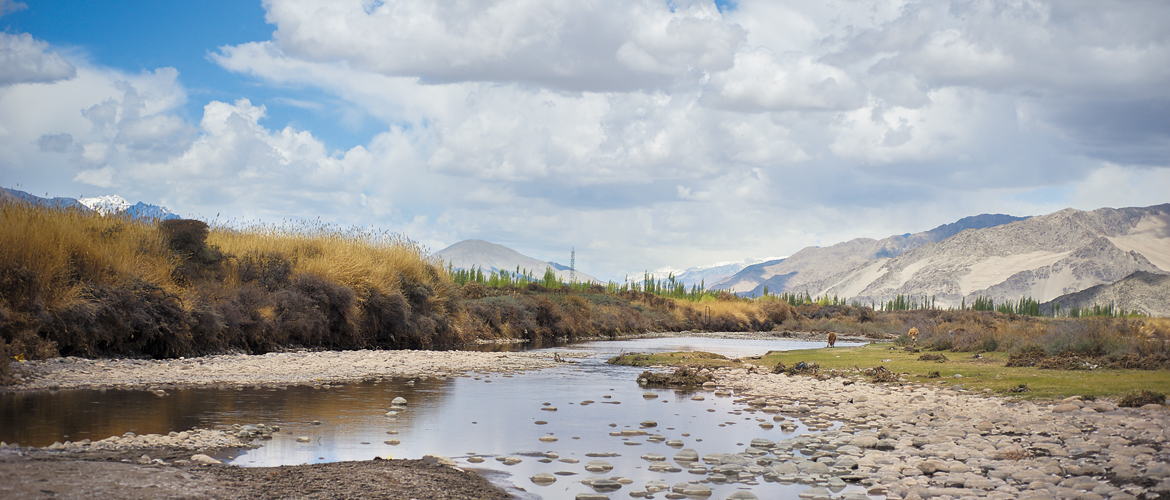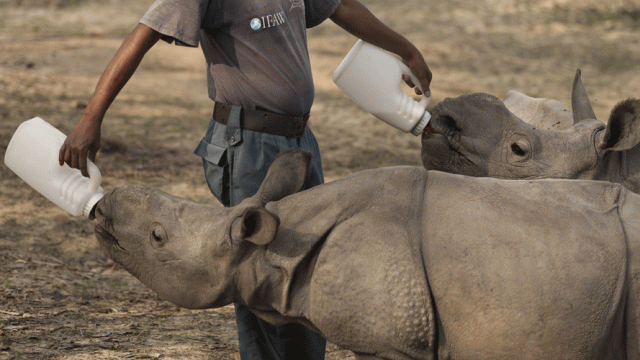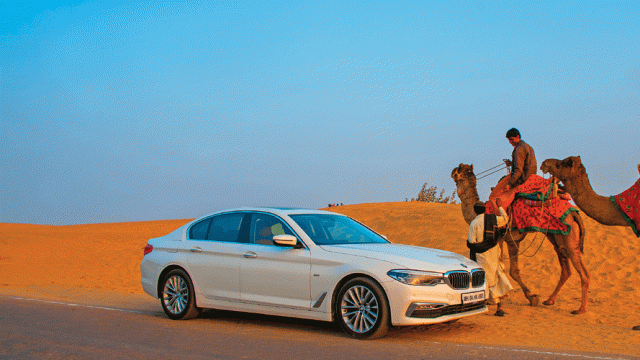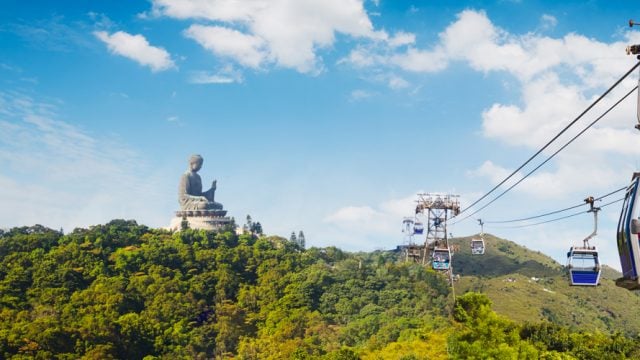VALLEY IN THE ROUGH
At Lukung (4,378m), the last Ladakhi village north of Pangong Tso accessible

May is an unpredictable month. Snowfall at higher altitudes translates into thick clouds, rainfall and gusty winds. However, under no circumstances, does this hinder farm activity—at the vertical edge of civilisation, the soil has very little nutrition, fresh water is scant, and the winter’s icy embrace knows no mercy. Speed is of essence; hence, everyone works each others’ field and rather than the yak or the dzo (a hybrid of a yak and a cow), uses the faster horse for ploughing. Then, the seed shows stubbornness, taking the whole of summer and autumn to grow. At Lukung, it is mainly peas, potatoes, spinach, turnips, and, most importantly, barley that equip families for the harsh winter. Dry meat is stocked up, mud brick homes are warmed with bukharis (heaters) and thaps (stoves), and winter is spent in the cosy indoors.

You are groggy after a challenging drive from Leh. Konchok Stobgais, a tour operator and camp owner, has been kind enough to chauffeur you around. The 150-odd-kilometre route that began at Leh (3,500m), steadily ascends to the snow-covered Chang La pass (5,360m) and then descends as Pangong nears.
Konchok is from Phobrang, just ahead of Lukung, and knows everyone in the area. The villagers belong to the semi-nomadic Changpa community, and you soon realise, are incredibly grounded people. Wangdus Dorje, a former soldier who has recently returned home, tells you, “even if the government doesn’t support us, we are capable of surviving and living in harmony.” It is quite a spectacular, self-sustaining arrangement—with barley at the crux. They use it to make sattu (barley flour), thukpa (noodle soup) and other items that constitute most meals.
Thankful for your help today, the owner of the field, Palden, offers you some chhaang (barley beer).

Soon the villagers settle in a circle outside Palden’s home, Konchok asks you to join them. You oblige, squeezing yourself between a group of red-cheeked girls and a man sporting fashionable aviators. You are served gur-gur (butter tea) with a dab of butter smeared on the rim of your kore (chhaang glass). “It is meant to be auspicious,” one of the girls informs you. Next comes an intriguing breakfast—thasroul (mixture of tsampa or roasted barley flour, gur-gur, and churpe or powdered cheese).

Usually families at Lukung offer their houses as homestays, but it was a busy day. So you spend a night in Tangtse, 40 kilometres towards Leh. This way, you are introduced to the kind family at DK Homestay. Both Tundup Dorje and his wife are teachers; their oldest son, Dawa, a guide and a historian; and their second son, an international-level ice hockey player. As you sit in the chansa (a Ladakhi kitchen-cum-living room) and admire the vast assortment of utensils, you slowly acquaint yourself with the hosts. You engage in animated conversation with Dawa, have Tundup narrate a joke or two, and watch Konchok help with the cooking. Gur-gur after gur-gur is served and a delicious Ladakhi staple is prepared for dinner—skyu (wheat bread in a watery vegetable curry). Later, you learn that this is where the 3 Idiots’ cast and crew stayed during filming. It is Tundup who helped Aamir Khan with the Ladakhi translation for his dialogue “Dorje, fly it [the drone]”, which he communicated to a boy (Tundup’s youngest son) towards the end of the film.
Though the room was cosy and the bed comfortable, the altitude gets the better of you. The next morning, as you depart for Leh, you are terribly in need of a boost, so you stop at a yak herder’s tent along the Durbuk-Zingral route. Inside sit two women also of the Changpa community. The older woman is shaking a container of yoghurt into butter, while the younger one, whose husband is uphill grazing his herd, gives you some yak tea. In the next 15 minutes, you try everything from yak cheese to buttermilk, and Konchok begins to get worried. “It will get too heavy for you,” he says. With all your Punjabi-ness, you respond, “no chance.”
SWEET HOME PHYANG
It is late afternoon. A ray of sunlight enters your snug room, as you lie cuddled under your blanket, as drowsy as a child awakened for school at the crack of dawn. You are resting after a long day that began in Tangtse, quite literally, at the crack of dawn. (Not to forget the four-hour drive that followed.)

At noon you had wound your way up Phyang’s village road to arrive at Skiltang Heritage Homestay, 20 kilometres from Leh. Here, you were welcomed by Yangchan, a schoolteacher, and her husband, Wangyal, a middle-aged retired army man who is now a contractor and Phyang’s nambardar (the village head). The couple and their family own the lovely abode, which became a homestay last year.
You decide not to rest for long. After all, every Ladakhi home is unique and boasts of an interesting back-story, and every minute spent in reverie is a missed opportunity. Skiltang, for instance, happens to be a farmstay or a homestay built on a farm. When the Students’ Educational and Cultural Movement of Ladakh (SECMOL) started their Ice Stupa project in Phyang a few years ago, founder Sonam Wangchuk and his team encouraged the setting up of homestays in the area. This one came up as a result.
The place has a century-and-a-half old house right next to the newer one, which the family once occupied. You accompany Wangyal and navigate your way through the tiny doors, dingy staircases, mud walls without a lick of paint, and rickety staircases. You marvel at this relic, imagining its past. You admire the ashen-colour chansa and the rusted bukhari, and study the disused stone thap. You enter the adjacent room, a store for grains scattered with antique ceremonial and utility-based paraphernalia.
From the roof, you get a splendid view of Phyang, with its monastery on your east, houses scattered all over, and farmland after farmland—some being ploughed with the dzo, others using tractors.
You enjoy the company of the 87-year-old Dorjy Dolma (always in a red beanie) and the 93-year-old Ishey Dolkar Dolma (always in a blue one). Real sisters and Wangyal’s two very twin-like mothers, they are not very talkative but constantly work. In the morning, you see them sit in the front lawn, separating malchang (willow) twigs. (Traditional Ladakhi homes have ceilings made of willow twigs and poplar logs.) By afternoon, they are watering the tomatoes, onions, cauliflowers, carrots and other vegetables in the garden. They also play with Becky, the pet Labrador, and her two-month-old puppy, Namga. Always jolly, they respond to your greeting with a lively julley! (hello) and infectious smiles.
With Wangyal, later, you visit the Ice Stupas at the gorge behind the village. Right by a stream, these are three cones with cave-like entrances made entirely of ice. A pipe brings them water from a higher source, which gathers momentum because of gravity. It is then sprinkled onto a frame, on which it freezes instantly because of the high velocity and small water droplets. This, essentially, helps store water in the form of an artificial glacier, which melts during the summer and greatly benefits the village. Inside one of the stupa caves, you even find an actual ice-sculpted stupa.

Back at Skiltang you look around the house. Tastefully done in vibrant colours, the rooms are carpeted, well-insulted, and spacious. There’s even a sitting area with a pastel-blue wall and plenty of potted plants. As night approaches, you join the family for dinner. Wangyal, though a teetotaller, is enthusiastic about serving you rum, and doesn’t take no for an answer. Both his mothers sit snacking, cutely drifting in and out of sleep and occasionally conversing in Ladakhi. Yangchan shows you a photo album with pictures displaying life in Phyang a few decades ago. Men are mostly dressed in gouchas (a thick woollen robe) and women in kuntops (similar to goucha). Momentarily, you feel part of the family. (Surely, in a Ladakhi homestay, that is meant to be the case.) To top it all, a delicious spread of rajma chawal, mattar paneer and egg curry is served.
CITY LIMITS
The line between the physical and the metaphysical seems blurry. While you have physically journeyed from the remote Lukung, to the semi-rural Phyang, and are about to visit Leh; you have also transitioned from one worldview to another—a semi-nomad, then a country-person, and now a townie.
Sadly, Leh, just by the virtue of being a city, fatigues you. Maybe you found the bucolic bliss of the past few days addictive. For a moment, the Main Bazaar and its promenade bedazzle you. However, your fellow traveller Puneet helps shatter that illusion—“there were so many historical buildings here before the renovation. Things feel so empty now.”

You find thousands of lamas (monks) wearing maroon kasayas (robes) deck the Bazaar’s street after the day’s Smonlam Chhenmo (a five-day annual prayer meet); at a distance, the dun-hued Leh Palace looks swell, but just below it, Ladakh’s old town, with its assortment of mud-brick homes and stupas, appears far more inviting; and at the Shey Bhumi boutique hotel, a 30 minute-drive away, the modern and the traditional achieve an equilibrium.
What was once a sea buckthorn orchard with a solitary house is today a campus with ten luxurious cottages. Located in Chuchot village, Shey Bhumi was started by Prashant Bisht and well-known business journalist Udayan Mukherjee, who let go of a leading position to focus on his love for the Himalaya. Arif, a Ladakhi youth whose family owns the land on which Shey Bhumi is built, tells you how Udayan immediately fell in love with the location and wished to make it the premier stay option for those seeking calm, a sense of local culture and, of course, luxury. The Shey Bhumi of today is his vision come to life.

The first cottage is the restaurant, but it might have been a homestay—similar double windows and small door, small multi-coloured Ladakhi tables or chokste, carpeted seating along the sides, vibrant pillars painted by monks, the traditional roofs and a cabinet lined with antique furniture, and a very conspicuous dzo skull. After all, this is the 150-year-old original cottage, where Arif’s family had stayed for generations. A few decades ago, they moved on, and the place was left with caretakers. Udayan and Prashant’s entry has, quite literally, given it a new lease of life.
Soon, the restaurant becomes your favourite hangout. You enjoy the company of Pramesh Agarwal, the manager, who can hold many-a-conversations. He show you around the campus—cottages spread across a six-acre area in a circular formation; a clearing in the middle that even functions as an outdoor dining area; and the famous Shey Monastery, after which the boutique hotel is named, visible at a short distance. You find your cottage adorable—with furniture as lively as the restaurant, painted with designs inspired by thangka (Buddhist art form) paintings, a cosy-as-it-gets bed and a tidy bathroom; what more do you need?

But for all its charm, Shey Bhumi’s biggest draw is its food. Ramesh da packs quite a punch with his cooking. You wondered how would he top the delicious kasuri khada masala chicken served on the first night, before you found the answer to that in the pahadi-style mutton curry you had on the third. He displays the same form in his Italian (a pink sauce pasta) on the second day and continental (lemon mustard sauce chicken) on the fourth.
Occasionally, you leave Shey Bhumi in the pursuit of the real Leh and you find solace in a visit to the Ladakh Arts and Media Organisation (LAMO), situation just a little below the Leh Palace. Headquartered in two 17th-century homes, in addition to its media- and art-based workshops and programmes, it’s a great place to explore the old quarter, known for 200 mud houses, and its gompas (centres of learning) and mosques that are able to transport you back in time.
On your drive back to the hotel, you are suggested a visit to an amchi or a doctor of Sowa–Rigpa (the Tibetan system of medicine). Since the practice is recognised by the Ministry of Ayush, there are amchis in hospitals and clinics, but a traditional one is far more intriguing.
When you arrive at Choglamsar, a village near Chuchot with a large Tibetan population, you learn that it is filled with lamos (oracles) and amchis. As you enter the home of amchi Kunzang Sherab, the septuagenarian is a little surprised at an outsider’s visit. You, however, genuinely want a cure for your ulcers. First, he checks your pulse and gauges, quite accurately, that you have a tendency to feel cold. He attributed it to a wind disorder, as an amchi’s diagnoses are mostly based on an elemental imbalance. For the ulcers, he recommends an anti-infection. You take the herbal medicine and decide to follow it religiously. You surprise yourself with the amount of trust you have in place for a medicine system you learned of the same morning. But, as you have gauged over the past week, this culture has its heart—and soul—at just the right place.
The Information
Getting There
Most domestic carriers fly directly from Delhi to Leh. If you’re driving down, it’s an approx. 1,000 km journey via the Leh– Manali Highway. Leh–Lukung is 151km/4hrs (via Chang La Pass and Tangste), Lukung–Tangste is 40km/1hr and Tangste-Phyang is 132km/3.5hrs (via Leh). Leh onward, unless you have your private vehicle, you will have to rent a taxi, even for sightseeing. Fixed union rates apply: ladakhtaxiunion.com/rate%20list.html.
Where To Stay
LUKUNG & TANGSTE: Lukung has 13 cosy homes, all of them homestays (approx. ₹1,000 per night including breakfast and dinner). They’re even more traditional than the ones I stayed in. Either reach the village and ask for accommodation, or call Konchok Stobgais (+91- 9469728072) to help you. Stay in DK Homestay at Tangste (₹700 per night, without food).
Call Tundup’s son, Dawa at +91-9419957890.
PHYANG: For the gorgeous Skiltang Heritage Homestay (₹1,600 doubles, including meals), call Wangyal (+91-9419178659). Rinchen Namgail (+91-9797337910), who is a field coordinator with SECMOL, can also connect you to other farmstays in the area. LEH: Shey Bhumi (₹14,000 per night with all meals, taxes extra; sheybhumi.com) is located in Chuchot village (18km/30min from Leh airport). Take one of their multi-day packages, each with itineraries that include sightseeing, guide cost, transportation cost and (depending on the package) visits to places such as Pangong Tso, Lamayuru and Nubra valley.
Where To Eat
TANGSTE: At DK Homestay, dinner costs `130 per person, and breakfast ₹50.
LEH: Outside of Shey Bhumi, I suggest Blue Lotus for pan-Asian, Il Forno for Italian and Lala’s Café (all in Leh Main Bazaar).
ELSEWHERE: It is a good idea to stop for tea, thukpa, mok-mok or maggi along the way at places such as Chang La or Durbok since the Leh–Tangste– Pangong drive could make you uncomfortable.
What To See & Do
LUKUNG & TANGSTE
>Interact with villagers/family members and assist them with farm activities.
>At Lukung, walk a bit along Pangong Tso lakeside.
>Do stop by the yak herder tents. Turns out, they are on the lookout for help and will even provide their second tent as accommodation.
PHYANG
>Visit the Ice Stupa. Also the Phyang Monastery at 6.00am for the daily prayer.
LEH
>At Shey Bhumi, go for a village walk, request for a bonfire, enjoy an outdoors meal (depending on weather) and, if it’s a large group, ask for a cultural show.
>Visit the plenty of attractions in and around Leh, such as Shey Palace, Thiksey Monastery, Hemis Monastery, Leh Palace and Shanti Stupa. Definitely go with a guide. I went with the super animated Rigzen Namgyal (+91-9622277157).
>At LAMO (below Leh Palace; lamo.org.in), Tashi Morup, Projects Director here, charges ₹2,000 per person for a tour of the old town.
>Visit amchi Kunzang Sherab (+91-9622001259). You can also reach him via amchi Norboo (+91- 9622955478). He had no fixed fee, so I gave ₹500 as donation.
Tips
>Travel between May and September, when the average temperature about 14°C.
>Carry Diamox tablets to counter high-altitude sickness.
>Get an Inner Line Permit for Lukung, Pangong and Tangtse on lahdclehpermit.in. It costs a person ₹400+₹20 a day. Get three photocopies made.
Ladakh
Ladakhi food
homestay





